Management Accounting: Cost Measurement, Budgeting & Control
VerifiedAdded on 2024/06/04
|25
|5551
|137
Report
AI Summary
This report provides a comprehensive overview of management accounting principles and their practical application within an organization facing financial challenges. It begins by defining management accounting and outlining its essential requirements, differentiating it from financial accounting. The report explores various management accounting techniques, including cost accounting systems (job costing and process costing), inventory management systems (EOQ and JIT), and price optimization systems. It then discusses different types of management reports, such as item-wise cost reports, sales to demand reports, and efficiency reports, highlighting their importance in organizational decision-making. The benefits of management accounting, including strategy foundation, future-based decision-making, expanded efficiency, and flexible reporting, are also examined. Furthermore, the report delves into marginal costing and absorption costing methods, providing income calculations and data interpretation. Finally, it analyzes planning tools used in budgetary control and their adoption in addressing financial issues, critically evaluating their role in achieving sustainable success. The report emphasizes the importance of proper implementation of management practices to overcome financial problems and enhance organizational performance.
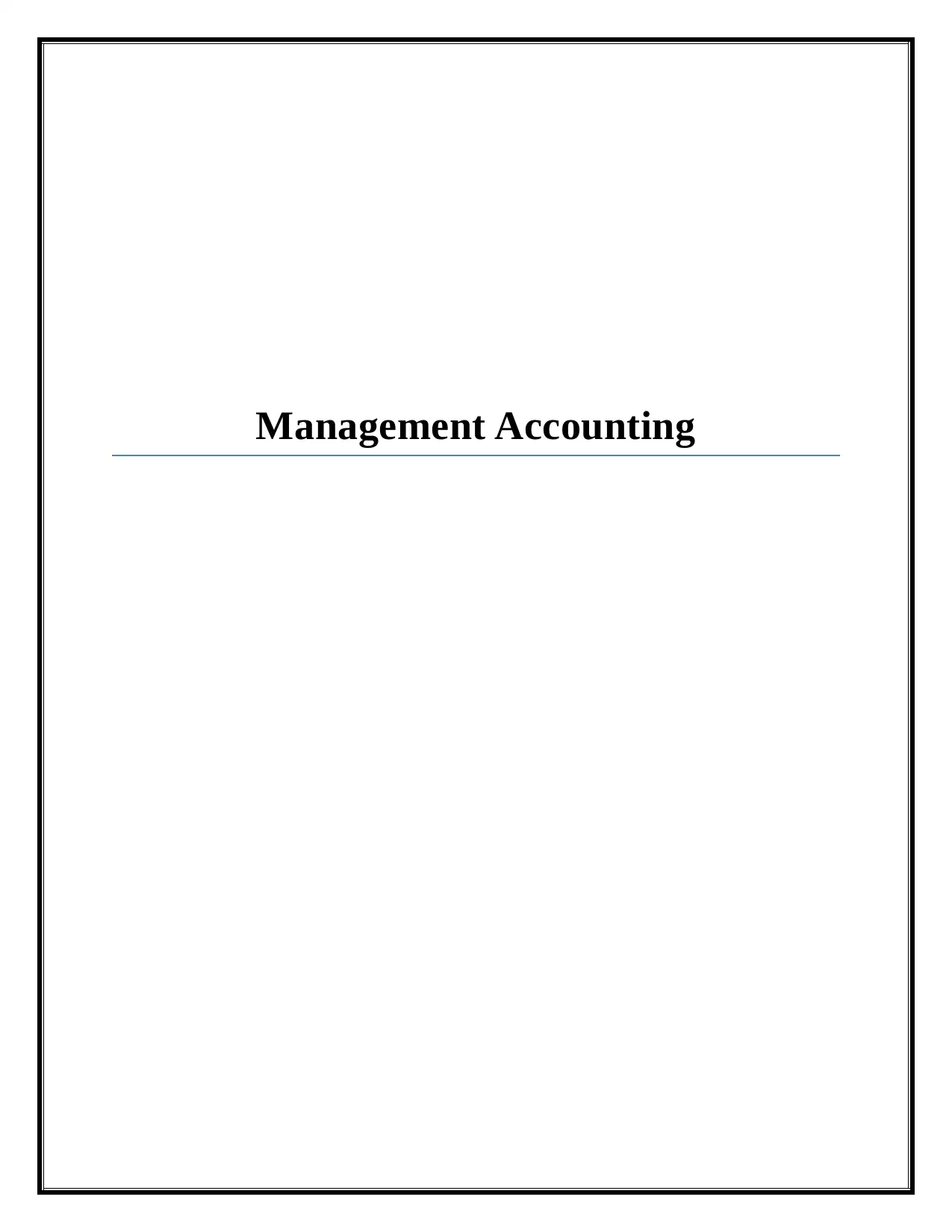
Management Accounting
Paraphrase This Document
Need a fresh take? Get an instant paraphrase of this document with our AI Paraphraser
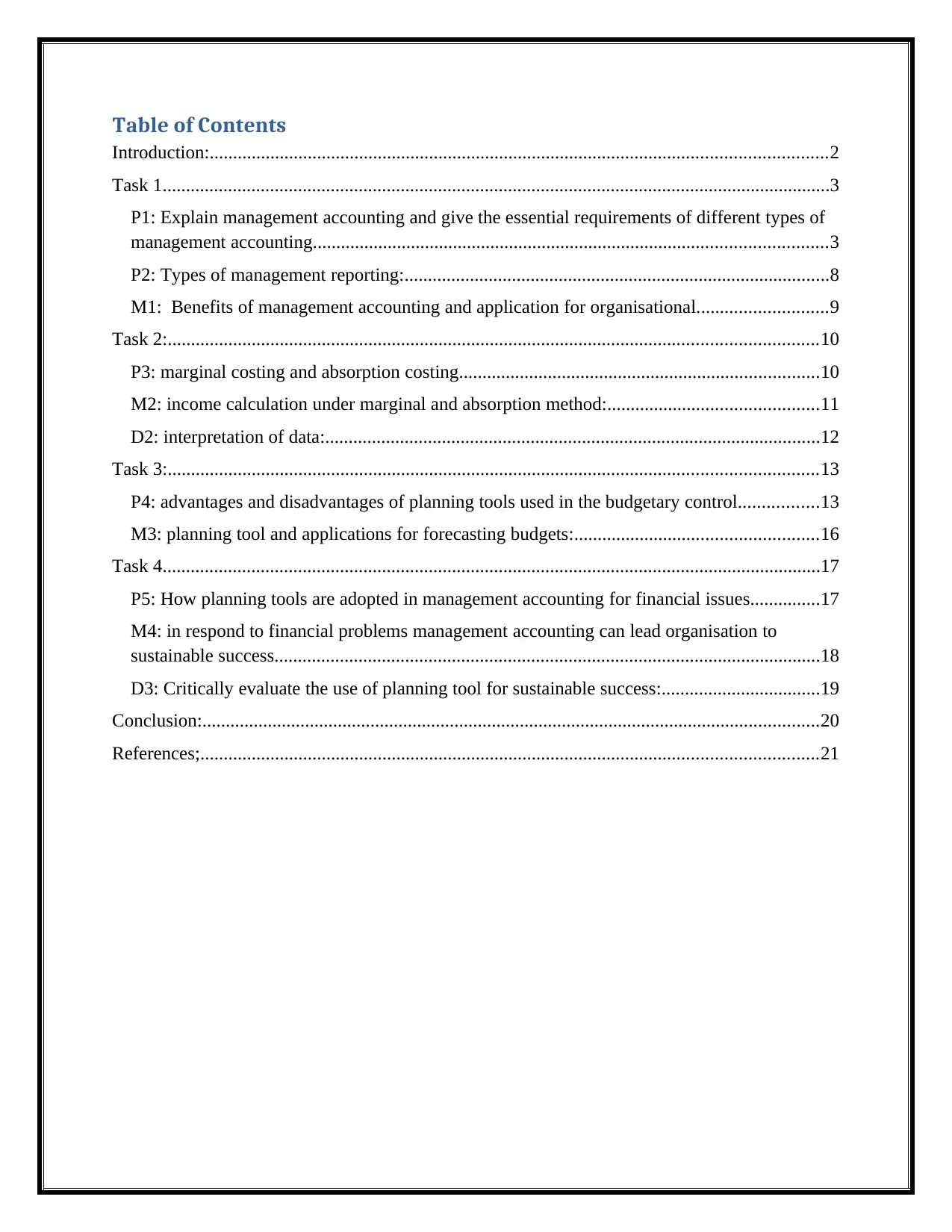
Table of Contents
Introduction:....................................................................................................................................2
Task 1...............................................................................................................................................3
P1: Explain management accounting and give the essential requirements of different types of
management accounting..............................................................................................................3
P2: Types of management reporting:...........................................................................................8
M1: Benefits of management accounting and application for organisational............................9
Task 2:...........................................................................................................................................10
P3: marginal costing and absorption costing.............................................................................10
M2: income calculation under marginal and absorption method:.............................................11
D2: interpretation of data:..........................................................................................................12
Task 3:...........................................................................................................................................13
P4: advantages and disadvantages of planning tools used in the budgetary control.................13
M3: planning tool and applications for forecasting budgets:....................................................16
Task 4.............................................................................................................................................17
P5: How planning tools are adopted in management accounting for financial issues...............17
M4: in respond to financial problems management accounting can lead organisation to
sustainable success.....................................................................................................................18
D3: Critically evaluate the use of planning tool for sustainable success:..................................19
Conclusion:....................................................................................................................................20
References;....................................................................................................................................21
Introduction:....................................................................................................................................2
Task 1...............................................................................................................................................3
P1: Explain management accounting and give the essential requirements of different types of
management accounting..............................................................................................................3
P2: Types of management reporting:...........................................................................................8
M1: Benefits of management accounting and application for organisational............................9
Task 2:...........................................................................................................................................10
P3: marginal costing and absorption costing.............................................................................10
M2: income calculation under marginal and absorption method:.............................................11
D2: interpretation of data:..........................................................................................................12
Task 3:...........................................................................................................................................13
P4: advantages and disadvantages of planning tools used in the budgetary control.................13
M3: planning tool and applications for forecasting budgets:....................................................16
Task 4.............................................................................................................................................17
P5: How planning tools are adopted in management accounting for financial issues...............17
M4: in respond to financial problems management accounting can lead organisation to
sustainable success.....................................................................................................................18
D3: Critically evaluate the use of planning tool for sustainable success:..................................19
Conclusion:....................................................................................................................................20
References;....................................................................................................................................21
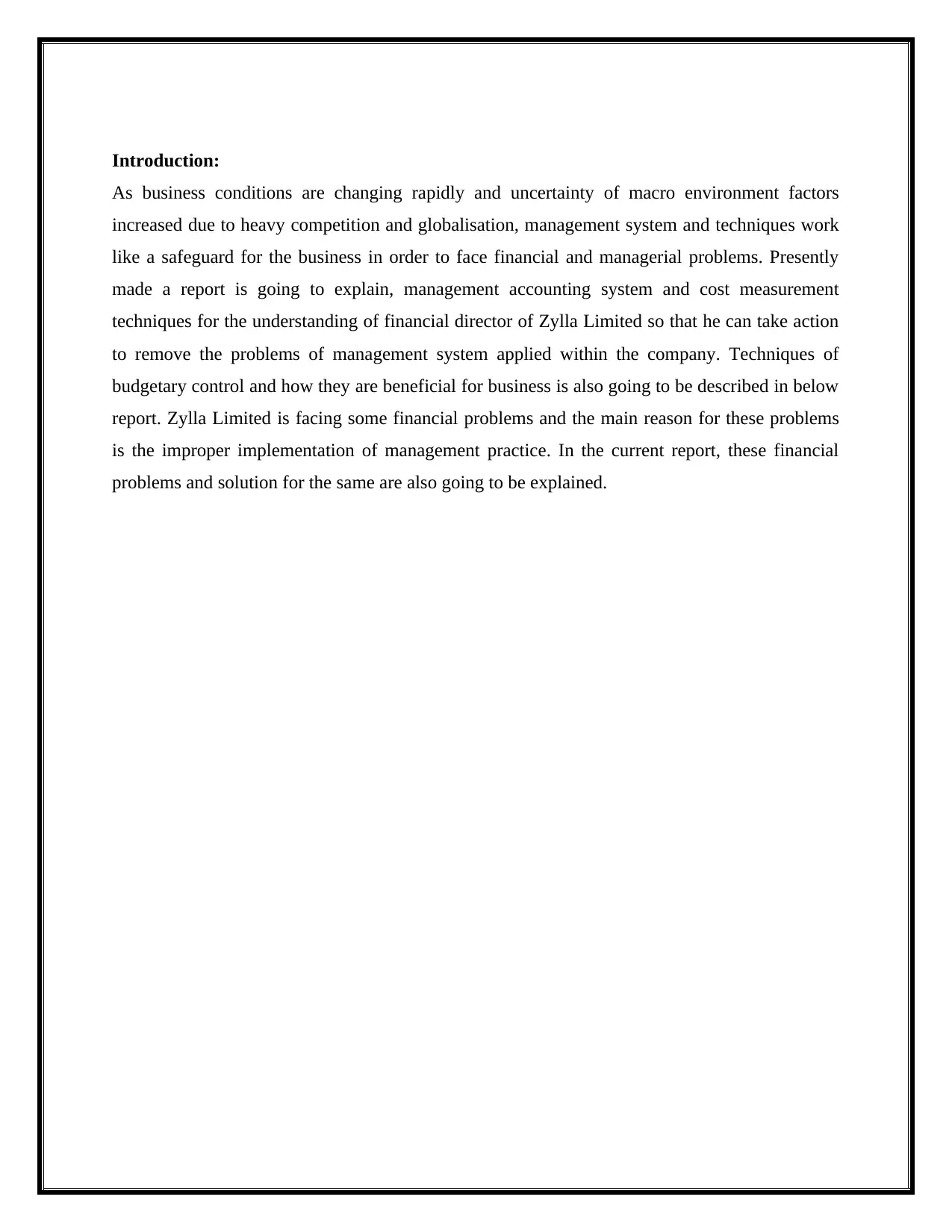
Introduction:
As business conditions are changing rapidly and uncertainty of macro environment factors
increased due to heavy competition and globalisation, management system and techniques work
like a safeguard for the business in order to face financial and managerial problems. Presently
made a report is going to explain, management accounting system and cost measurement
techniques for the understanding of financial director of Zylla Limited so that he can take action
to remove the problems of management system applied within the company. Techniques of
budgetary control and how they are beneficial for business is also going to be described in below
report. Zylla Limited is facing some financial problems and the main reason for these problems
is the improper implementation of management practice. In the current report, these financial
problems and solution for the same are also going to be explained.
As business conditions are changing rapidly and uncertainty of macro environment factors
increased due to heavy competition and globalisation, management system and techniques work
like a safeguard for the business in order to face financial and managerial problems. Presently
made a report is going to explain, management accounting system and cost measurement
techniques for the understanding of financial director of Zylla Limited so that he can take action
to remove the problems of management system applied within the company. Techniques of
budgetary control and how they are beneficial for business is also going to be described in below
report. Zylla Limited is facing some financial problems and the main reason for these problems
is the improper implementation of management practice. In the current report, these financial
problems and solution for the same are also going to be explained.
⊘ This is a preview!⊘
Do you want full access?
Subscribe today to unlock all pages.

Trusted by 1+ million students worldwide
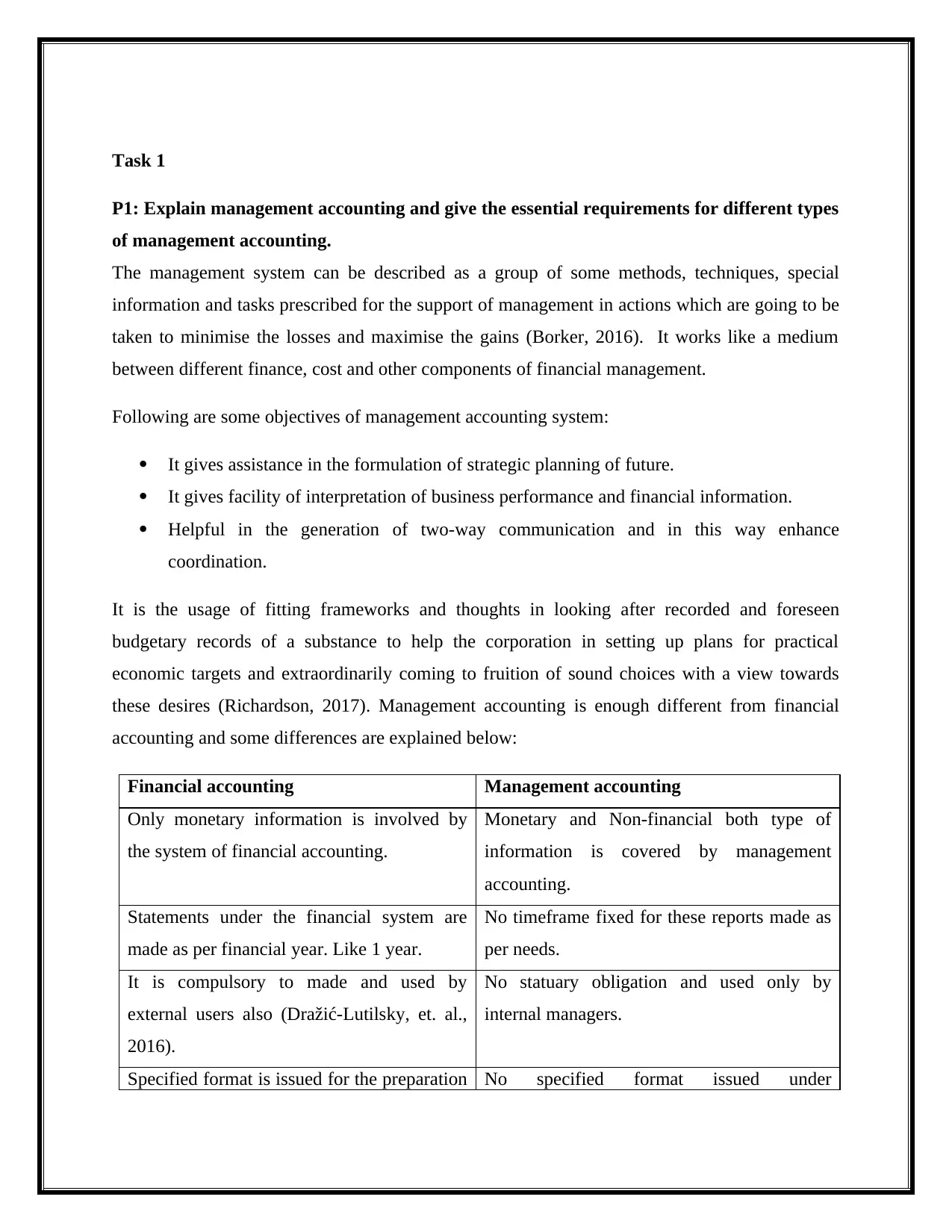
Task 1
P1: Explain management accounting and give the essential requirements for different types
of management accounting.
The management system can be described as a group of some methods, techniques, special
information and tasks prescribed for the support of management in actions which are going to be
taken to minimise the losses and maximise the gains (Borker, 2016). It works like a medium
between different finance, cost and other components of financial management.
Following are some objectives of management accounting system:
It gives assistance in the formulation of strategic planning of future.
It gives facility of interpretation of business performance and financial information.
Helpful in the generation of two-way communication and in this way enhance
coordination.
It is the usage of fitting frameworks and thoughts in looking after recorded and foreseen
budgetary records of a substance to help the corporation in setting up plans for practical
economic targets and extraordinarily coming to fruition of sound choices with a view towards
these desires (Richardson, 2017). Management accounting is enough different from financial
accounting and some differences are explained below:
Financial accounting Management accounting
Only monetary information is involved by
the system of financial accounting.
Monetary and Non-financial both type of
information is covered by management
accounting.
Statements under the financial system are
made as per financial year. Like 1 year.
No timeframe fixed for these reports made as
per needs.
It is compulsory to made and used by
external users also (Dražić-Lutilsky, et. al.,
2016).
No statuary obligation and used only by
internal managers.
Specified format is issued for the preparation No specified format issued under
P1: Explain management accounting and give the essential requirements for different types
of management accounting.
The management system can be described as a group of some methods, techniques, special
information and tasks prescribed for the support of management in actions which are going to be
taken to minimise the losses and maximise the gains (Borker, 2016). It works like a medium
between different finance, cost and other components of financial management.
Following are some objectives of management accounting system:
It gives assistance in the formulation of strategic planning of future.
It gives facility of interpretation of business performance and financial information.
Helpful in the generation of two-way communication and in this way enhance
coordination.
It is the usage of fitting frameworks and thoughts in looking after recorded and foreseen
budgetary records of a substance to help the corporation in setting up plans for practical
economic targets and extraordinarily coming to fruition of sound choices with a view towards
these desires (Richardson, 2017). Management accounting is enough different from financial
accounting and some differences are explained below:
Financial accounting Management accounting
Only monetary information is involved by
the system of financial accounting.
Monetary and Non-financial both type of
information is covered by management
accounting.
Statements under the financial system are
made as per financial year. Like 1 year.
No timeframe fixed for these reports made as
per needs.
It is compulsory to made and used by
external users also (Dražić-Lutilsky, et. al.,
2016).
No statuary obligation and used only by
internal managers.
Specified format is issued for the preparation No specified format issued under
Paraphrase This Document
Need a fresh take? Get an instant paraphrase of this document with our AI Paraphraser
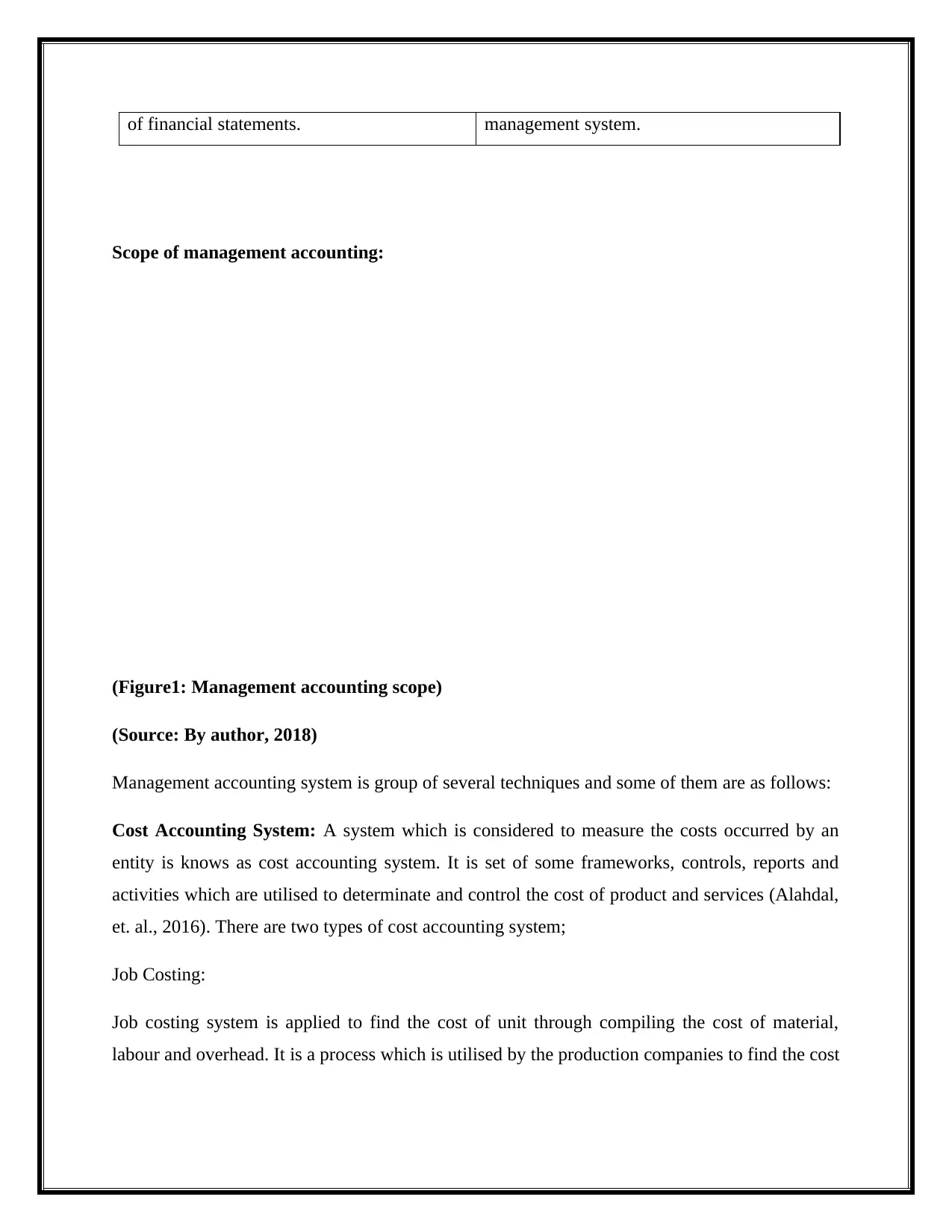
of financial statements. management system.
Scope of management accounting:
(Figure1: Management accounting scope)
(Source: By author, 2018)
Management accounting system is group of several techniques and some of them are as follows:
Cost Accounting System: A system which is considered to measure the costs occurred by an
entity is knows as cost accounting system. It is set of some frameworks, controls, reports and
activities which are utilised to determinate and control the cost of product and services (Alahdal,
et. al., 2016). There are two types of cost accounting system;
Job Costing:
Job costing system is applied to find the cost of unit through compiling the cost of material,
labour and overhead. It is a process which is utilised by the production companies to find the cost
Scope of management accounting:
(Figure1: Management accounting scope)
(Source: By author, 2018)
Management accounting system is group of several techniques and some of them are as follows:
Cost Accounting System: A system which is considered to measure the costs occurred by an
entity is knows as cost accounting system. It is set of some frameworks, controls, reports and
activities which are utilised to determinate and control the cost of product and services (Alahdal,
et. al., 2016). There are two types of cost accounting system;
Job Costing:
Job costing system is applied to find the cost of unit through compiling the cost of material,
labour and overhead. It is a process which is utilised by the production companies to find the cost
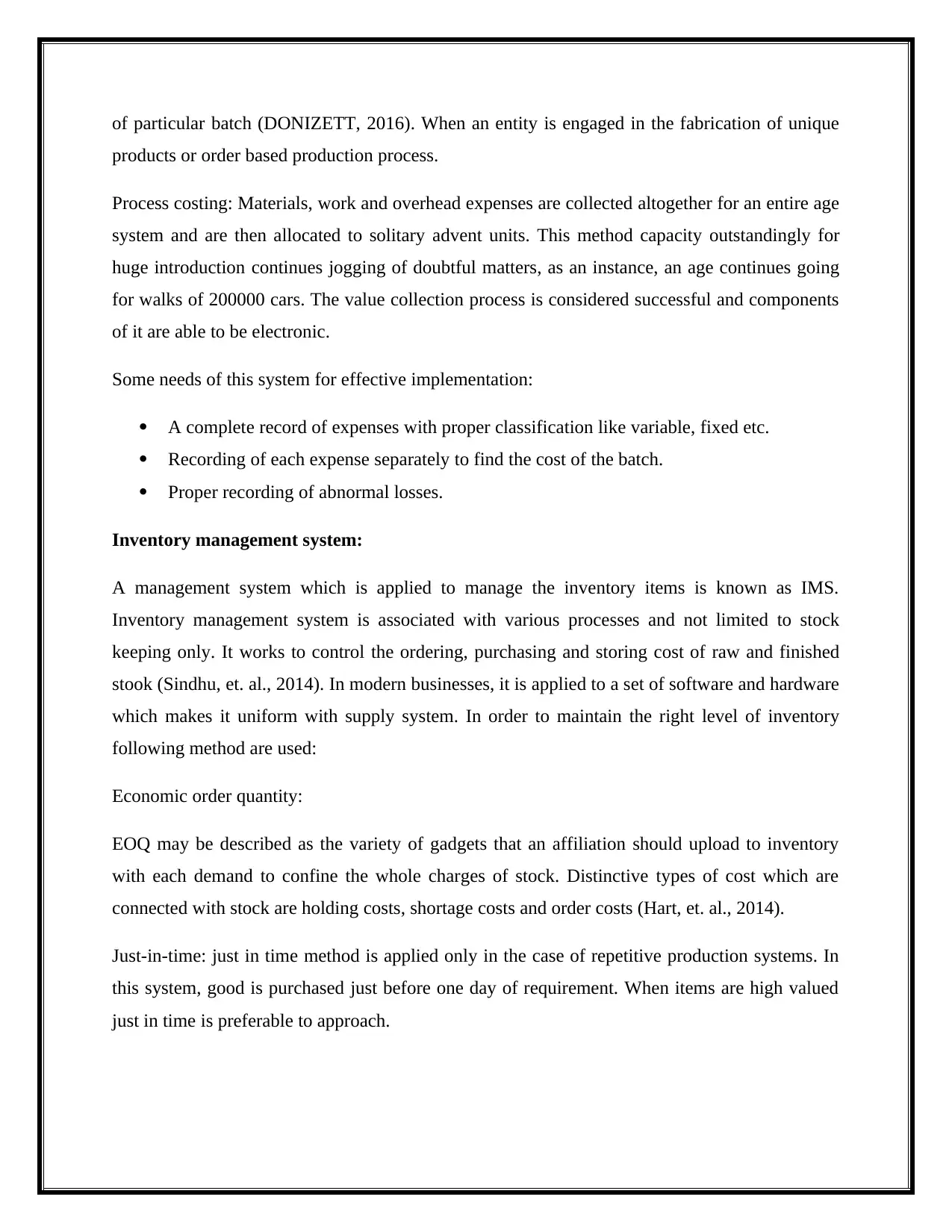
of particular batch (DONIZETT, 2016). When an entity is engaged in the fabrication of unique
products or order based production process.
Process costing: Materials, work and overhead expenses are collected altogether for an entire age
system and are then allocated to solitary advent units. This method capacity outstandingly for
huge introduction continues jogging of doubtful matters, as an instance, an age continues going
for walks of 200000 cars. The value collection process is considered successful and components
of it are able to be electronic.
Some needs of this system for effective implementation:
A complete record of expenses with proper classification like variable, fixed etc.
Recording of each expense separately to find the cost of the batch.
Proper recording of abnormal losses.
Inventory management system:
A management system which is applied to manage the inventory items is known as IMS.
Inventory management system is associated with various processes and not limited to stock
keeping only. It works to control the ordering, purchasing and storing cost of raw and finished
stook (Sindhu, et. al., 2014). In modern businesses, it is applied to a set of software and hardware
which makes it uniform with supply system. In order to maintain the right level of inventory
following method are used:
Economic order quantity:
EOQ may be described as the variety of gadgets that an affiliation should upload to inventory
with each demand to confine the whole charges of stock. Distinctive types of cost which are
connected with stock are holding costs, shortage costs and order costs (Hart, et. al., 2014).
Just-in-time: just in time method is applied only in the case of repetitive production systems. In
this system, good is purchased just before one day of requirement. When items are high valued
just in time is preferable to approach.
products or order based production process.
Process costing: Materials, work and overhead expenses are collected altogether for an entire age
system and are then allocated to solitary advent units. This method capacity outstandingly for
huge introduction continues jogging of doubtful matters, as an instance, an age continues going
for walks of 200000 cars. The value collection process is considered successful and components
of it are able to be electronic.
Some needs of this system for effective implementation:
A complete record of expenses with proper classification like variable, fixed etc.
Recording of each expense separately to find the cost of the batch.
Proper recording of abnormal losses.
Inventory management system:
A management system which is applied to manage the inventory items is known as IMS.
Inventory management system is associated with various processes and not limited to stock
keeping only. It works to control the ordering, purchasing and storing cost of raw and finished
stook (Sindhu, et. al., 2014). In modern businesses, it is applied to a set of software and hardware
which makes it uniform with supply system. In order to maintain the right level of inventory
following method are used:
Economic order quantity:
EOQ may be described as the variety of gadgets that an affiliation should upload to inventory
with each demand to confine the whole charges of stock. Distinctive types of cost which are
connected with stock are holding costs, shortage costs and order costs (Hart, et. al., 2014).
Just-in-time: just in time method is applied only in the case of repetitive production systems. In
this system, good is purchased just before one day of requirement. When items are high valued
just in time is preferable to approach.
⊘ This is a preview!⊘
Do you want full access?
Subscribe today to unlock all pages.

Trusted by 1+ million students worldwide
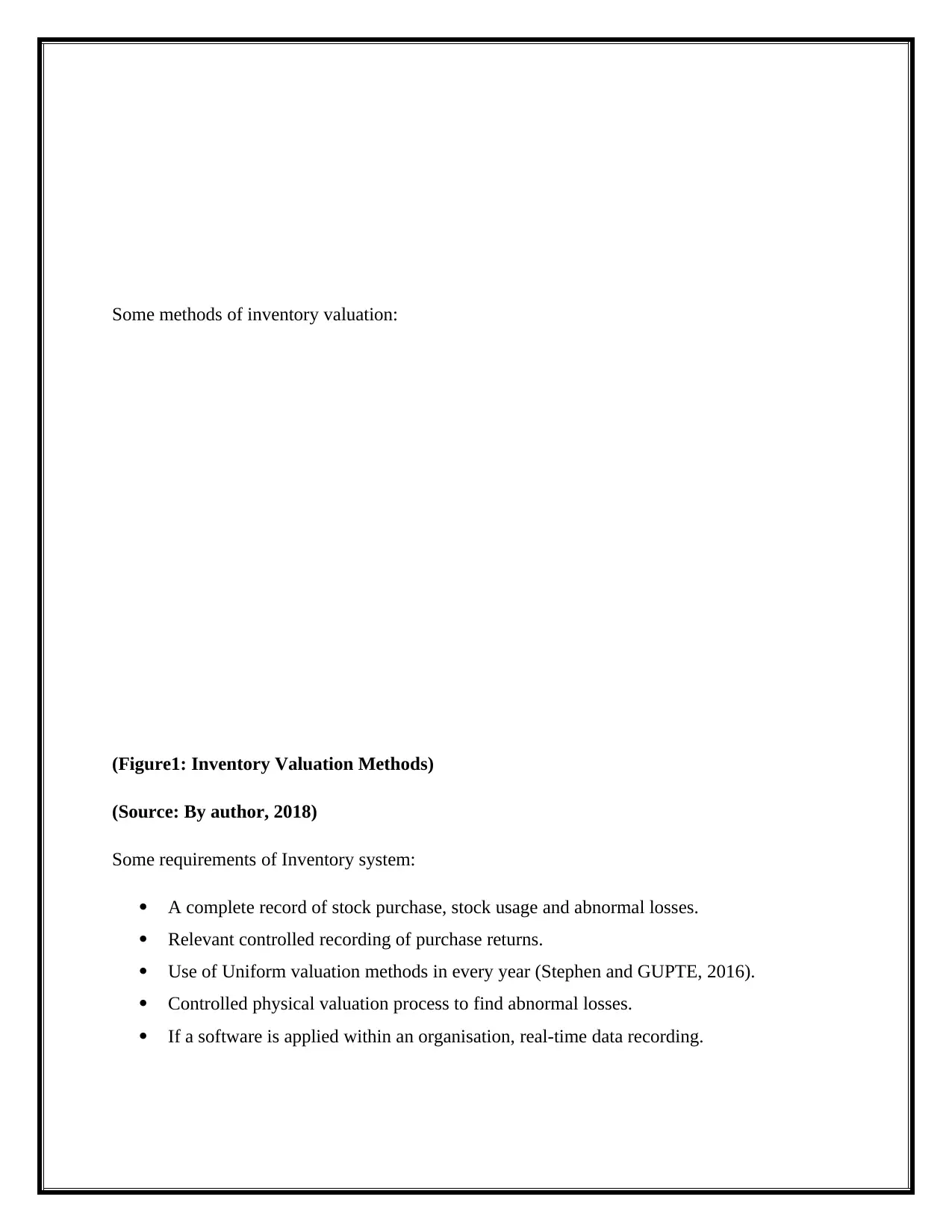
Some methods of inventory valuation:
(Figure1: Inventory Valuation Methods)
(Source: By author, 2018)
Some requirements of Inventory system:
A complete record of stock purchase, stock usage and abnormal losses.
Relevant controlled recording of purchase returns.
Use of Uniform valuation methods in every year (Stephen and GUPTE, 2016).
Controlled physical valuation process to find abnormal losses.
If a software is applied within an organisation, real-time data recording.
(Figure1: Inventory Valuation Methods)
(Source: By author, 2018)
Some requirements of Inventory system:
A complete record of stock purchase, stock usage and abnormal losses.
Relevant controlled recording of purchase returns.
Use of Uniform valuation methods in every year (Stephen and GUPTE, 2016).
Controlled physical valuation process to find abnormal losses.
If a software is applied within an organisation, real-time data recording.
Paraphrase This Document
Need a fresh take? Get an instant paraphrase of this document with our AI Paraphraser
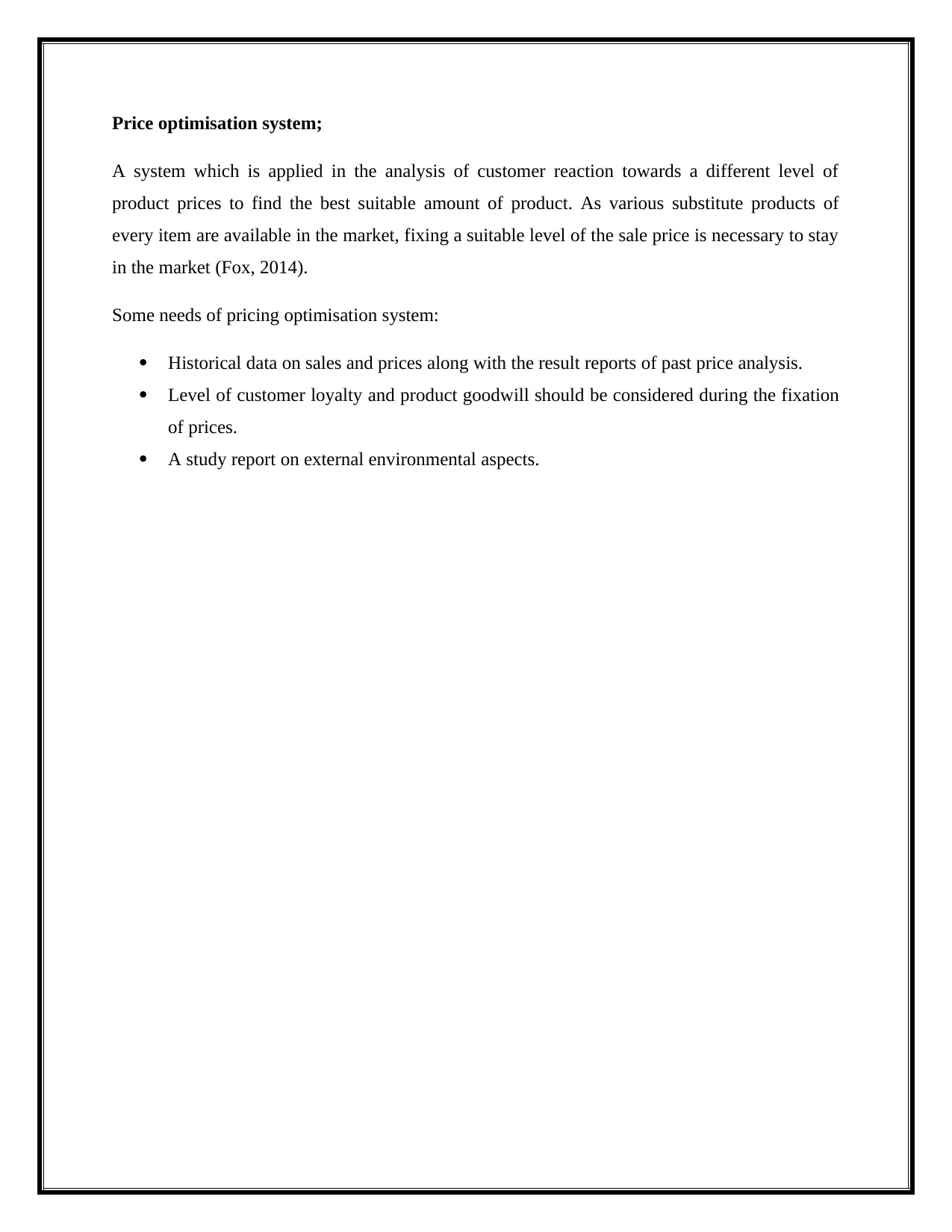
Price optimisation system;
A system which is applied in the analysis of customer reaction towards a different level of
product prices to find the best suitable amount of product. As various substitute products of
every item are available in the market, fixing a suitable level of the sale price is necessary to stay
in the market (Fox, 2014).
Some needs of pricing optimisation system:
Historical data on sales and prices along with the result reports of past price analysis.
Level of customer loyalty and product goodwill should be considered during the fixation
of prices.
A study report on external environmental aspects.
A system which is applied in the analysis of customer reaction towards a different level of
product prices to find the best suitable amount of product. As various substitute products of
every item are available in the market, fixing a suitable level of the sale price is necessary to stay
in the market (Fox, 2014).
Some needs of pricing optimisation system:
Historical data on sales and prices along with the result reports of past price analysis.
Level of customer loyalty and product goodwill should be considered during the fixation
of prices.
A study report on external environmental aspects.
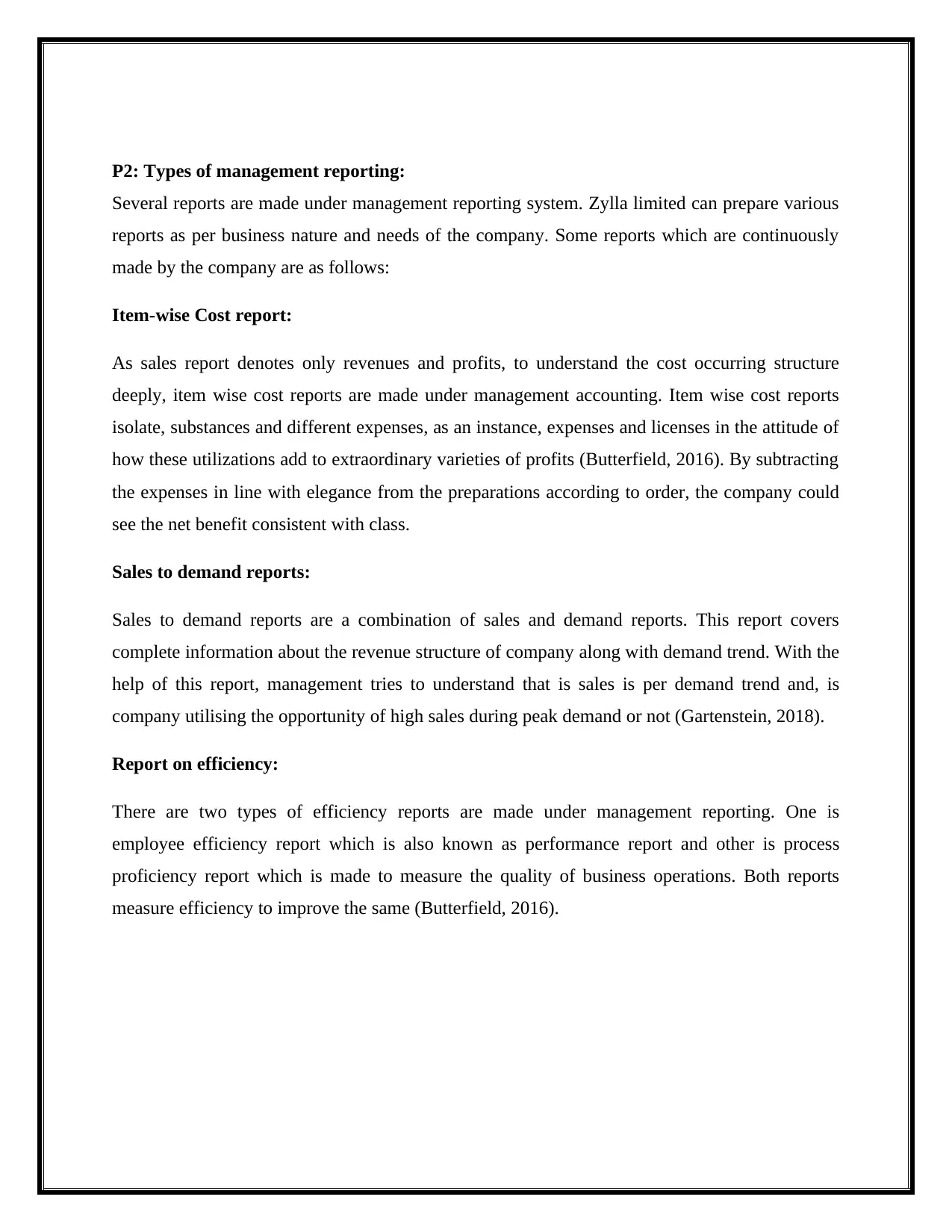
P2: Types of management reporting:
Several reports are made under management reporting system. Zylla limited can prepare various
reports as per business nature and needs of the company. Some reports which are continuously
made by the company are as follows:
Item-wise Cost report:
As sales report denotes only revenues and profits, to understand the cost occurring structure
deeply, item wise cost reports are made under management accounting. Item wise cost reports
isolate, substances and different expenses, as an instance, expenses and licenses in the attitude of
how these utilizations add to extraordinary varieties of profits (Butterfield, 2016). By subtracting
the expenses in line with elegance from the preparations according to order, the company could
see the net benefit consistent with class.
Sales to demand reports:
Sales to demand reports are a combination of sales and demand reports. This report covers
complete information about the revenue structure of company along with demand trend. With the
help of this report, management tries to understand that is sales is per demand trend and, is
company utilising the opportunity of high sales during peak demand or not (Gartenstein, 2018).
Report on efficiency:
There are two types of efficiency reports are made under management reporting. One is
employee efficiency report which is also known as performance report and other is process
proficiency report which is made to measure the quality of business operations. Both reports
measure efficiency to improve the same (Butterfield, 2016).
Several reports are made under management reporting system. Zylla limited can prepare various
reports as per business nature and needs of the company. Some reports which are continuously
made by the company are as follows:
Item-wise Cost report:
As sales report denotes only revenues and profits, to understand the cost occurring structure
deeply, item wise cost reports are made under management accounting. Item wise cost reports
isolate, substances and different expenses, as an instance, expenses and licenses in the attitude of
how these utilizations add to extraordinary varieties of profits (Butterfield, 2016). By subtracting
the expenses in line with elegance from the preparations according to order, the company could
see the net benefit consistent with class.
Sales to demand reports:
Sales to demand reports are a combination of sales and demand reports. This report covers
complete information about the revenue structure of company along with demand trend. With the
help of this report, management tries to understand that is sales is per demand trend and, is
company utilising the opportunity of high sales during peak demand or not (Gartenstein, 2018).
Report on efficiency:
There are two types of efficiency reports are made under management reporting. One is
employee efficiency report which is also known as performance report and other is process
proficiency report which is made to measure the quality of business operations. Both reports
measure efficiency to improve the same (Butterfield, 2016).
⊘ This is a preview!⊘
Do you want full access?
Subscribe today to unlock all pages.

Trusted by 1+ million students worldwide
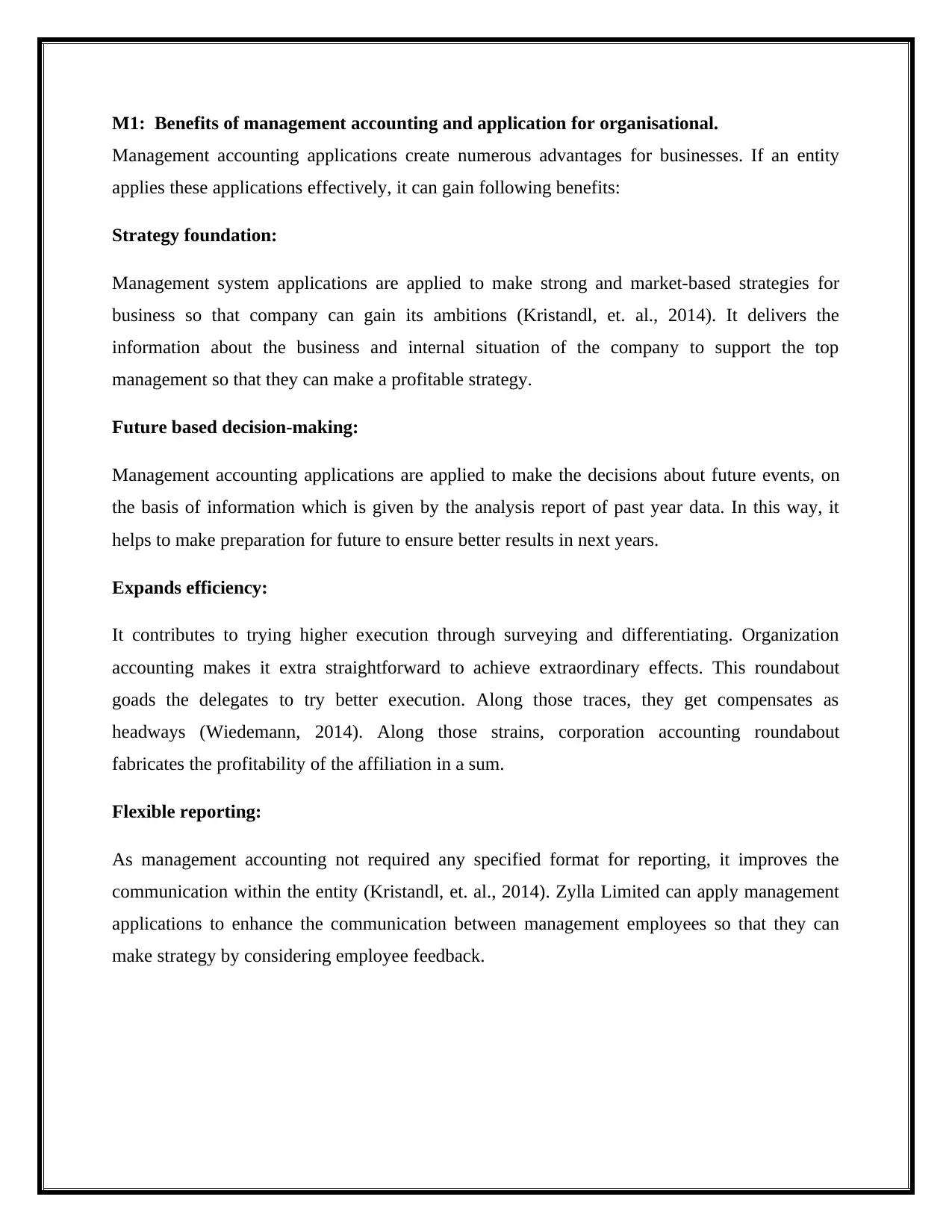
M1: Benefits of management accounting and application for organisational.
Management accounting applications create numerous advantages for businesses. If an entity
applies these applications effectively, it can gain following benefits:
Strategy foundation:
Management system applications are applied to make strong and market-based strategies for
business so that company can gain its ambitions (Kristandl, et. al., 2014). It delivers the
information about the business and internal situation of the company to support the top
management so that they can make a profitable strategy.
Future based decision-making:
Management accounting applications are applied to make the decisions about future events, on
the basis of information which is given by the analysis report of past year data. In this way, it
helps to make preparation for future to ensure better results in next years.
Expands efficiency:
It contributes to trying higher execution through surveying and differentiating. Organization
accounting makes it extra straightforward to achieve extraordinary effects. This roundabout
goads the delegates to try better execution. Along those traces, they get compensates as
headways (Wiedemann, 2014). Along those strains, corporation accounting roundabout
fabricates the profitability of the affiliation in a sum.
Flexible reporting:
As management accounting not required any specified format for reporting, it improves the
communication within the entity (Kristandl, et. al., 2014). Zylla Limited can apply management
applications to enhance the communication between management employees so that they can
make strategy by considering employee feedback.
Management accounting applications create numerous advantages for businesses. If an entity
applies these applications effectively, it can gain following benefits:
Strategy foundation:
Management system applications are applied to make strong and market-based strategies for
business so that company can gain its ambitions (Kristandl, et. al., 2014). It delivers the
information about the business and internal situation of the company to support the top
management so that they can make a profitable strategy.
Future based decision-making:
Management accounting applications are applied to make the decisions about future events, on
the basis of information which is given by the analysis report of past year data. In this way, it
helps to make preparation for future to ensure better results in next years.
Expands efficiency:
It contributes to trying higher execution through surveying and differentiating. Organization
accounting makes it extra straightforward to achieve extraordinary effects. This roundabout
goads the delegates to try better execution. Along those traces, they get compensates as
headways (Wiedemann, 2014). Along those strains, corporation accounting roundabout
fabricates the profitability of the affiliation in a sum.
Flexible reporting:
As management accounting not required any specified format for reporting, it improves the
communication within the entity (Kristandl, et. al., 2014). Zylla Limited can apply management
applications to enhance the communication between management employees so that they can
make strategy by considering employee feedback.
Paraphrase This Document
Need a fresh take? Get an instant paraphrase of this document with our AI Paraphraser
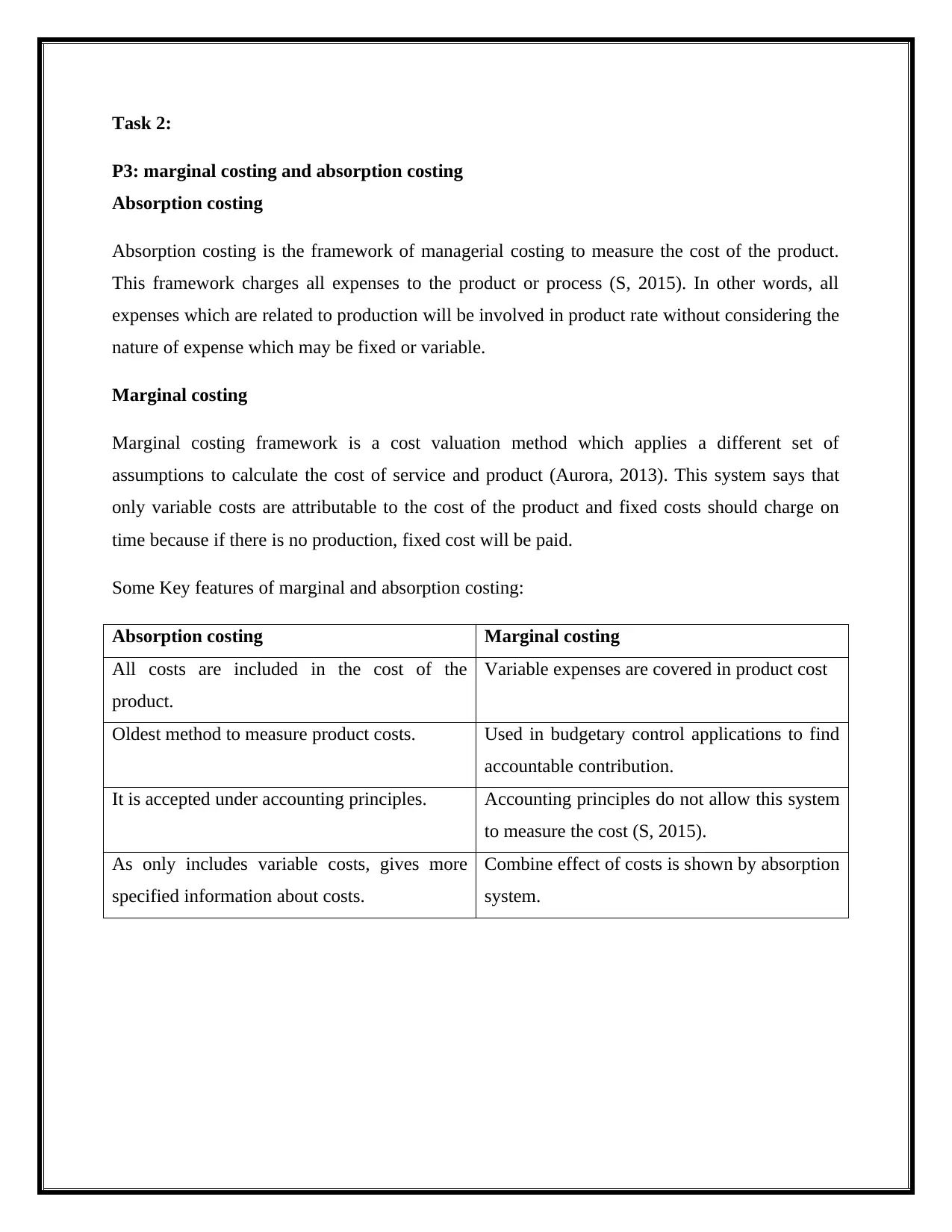
Task 2:
P3: marginal costing and absorption costing
Absorption costing
Absorption costing is the framework of managerial costing to measure the cost of the product.
This framework charges all expenses to the product or process (S, 2015). In other words, all
expenses which are related to production will be involved in product rate without considering the
nature of expense which may be fixed or variable.
Marginal costing
Marginal costing framework is a cost valuation method which applies a different set of
assumptions to calculate the cost of service and product (Aurora, 2013). This system says that
only variable costs are attributable to the cost of the product and fixed costs should charge on
time because if there is no production, fixed cost will be paid.
Some Key features of marginal and absorption costing:
Absorption costing Marginal costing
All costs are included in the cost of the
product.
Variable expenses are covered in product cost
Oldest method to measure product costs. Used in budgetary control applications to find
accountable contribution.
It is accepted under accounting principles. Accounting principles do not allow this system
to measure the cost (S, 2015).
As only includes variable costs, gives more
specified information about costs.
Combine effect of costs is shown by absorption
system.
P3: marginal costing and absorption costing
Absorption costing
Absorption costing is the framework of managerial costing to measure the cost of the product.
This framework charges all expenses to the product or process (S, 2015). In other words, all
expenses which are related to production will be involved in product rate without considering the
nature of expense which may be fixed or variable.
Marginal costing
Marginal costing framework is a cost valuation method which applies a different set of
assumptions to calculate the cost of service and product (Aurora, 2013). This system says that
only variable costs are attributable to the cost of the product and fixed costs should charge on
time because if there is no production, fixed cost will be paid.
Some Key features of marginal and absorption costing:
Absorption costing Marginal costing
All costs are included in the cost of the
product.
Variable expenses are covered in product cost
Oldest method to measure product costs. Used in budgetary control applications to find
accountable contribution.
It is accepted under accounting principles. Accounting principles do not allow this system
to measure the cost (S, 2015).
As only includes variable costs, gives more
specified information about costs.
Combine effect of costs is shown by absorption
system.
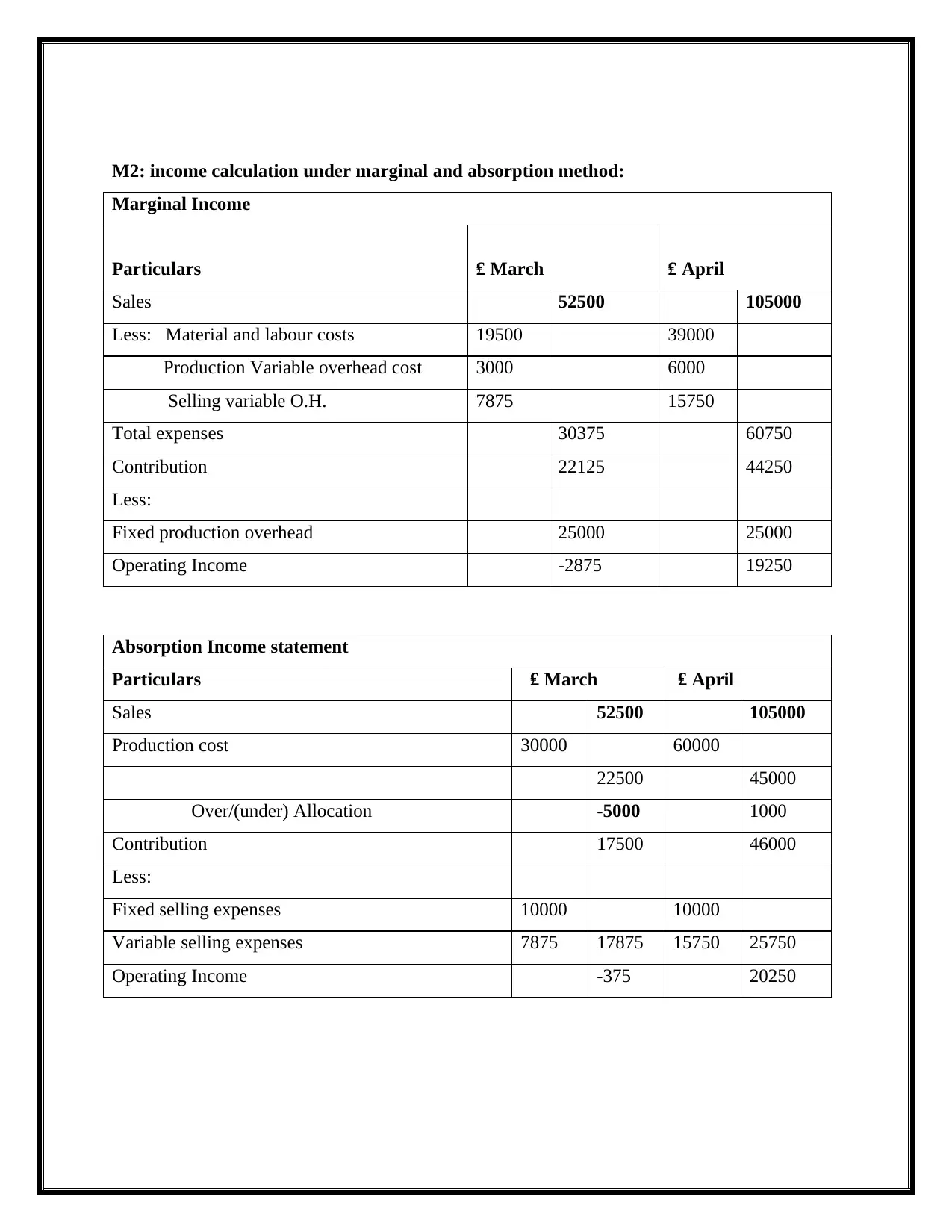
M2: income calculation under marginal and absorption method:
Marginal Income
Particulars ₤ March ₤ April
Sales 52500 105000
Less: Material and labour costs 19500 39000
Production Variable overhead cost 3000 6000
Selling variable O.H. 7875 15750
Total expenses 30375 60750
Contribution 22125 44250
Less:
Fixed production overhead 25000 25000
Operating Income -2875 19250
Absorption Income statement
Particulars ₤ March ₤ April
Sales 52500 105000
Production cost 30000 60000
22500 45000
Over/(under) Allocation -5000 1000
Contribution 17500 46000
Less:
Fixed selling expenses 10000 10000
Variable selling expenses 7875 17875 15750 25750
Operating Income -375 20250
Marginal Income
Particulars ₤ March ₤ April
Sales 52500 105000
Less: Material and labour costs 19500 39000
Production Variable overhead cost 3000 6000
Selling variable O.H. 7875 15750
Total expenses 30375 60750
Contribution 22125 44250
Less:
Fixed production overhead 25000 25000
Operating Income -2875 19250
Absorption Income statement
Particulars ₤ March ₤ April
Sales 52500 105000
Production cost 30000 60000
22500 45000
Over/(under) Allocation -5000 1000
Contribution 17500 46000
Less:
Fixed selling expenses 10000 10000
Variable selling expenses 7875 17875 15750 25750
Operating Income -375 20250
⊘ This is a preview!⊘
Do you want full access?
Subscribe today to unlock all pages.

Trusted by 1+ million students worldwide
1 out of 25
Related Documents
Your All-in-One AI-Powered Toolkit for Academic Success.
+13062052269
info@desklib.com
Available 24*7 on WhatsApp / Email
![[object Object]](/_next/static/media/star-bottom.7253800d.svg)
Unlock your academic potential
Copyright © 2020–2025 A2Z Services. All Rights Reserved. Developed and managed by ZUCOL.





